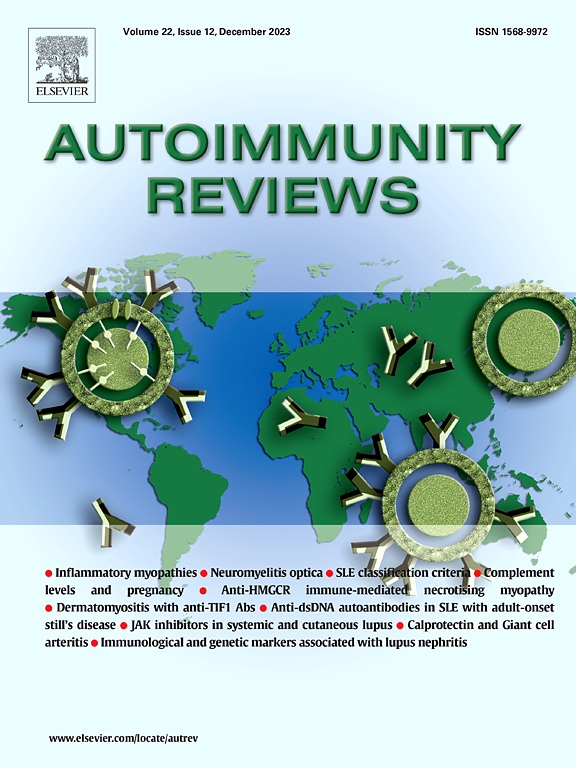The emerging concept of ANCA-associated vasculitis related to inborn errors of immunity
IF 8.3
1区 医学
Q1 IMMUNOLOGY
引用次数: 0
Abstract
ANCA-associated vasculitis (AAV) is a group of rare small vessels vasculitis that preferentially affect the kidneys, lungs and upper airways. Although the detailed pathophysiology remains unclear, genetic background has been shown to play a role in sporadic forms of AAV. The discovery of these susceptibility genes (and associated biological pathways) involved in AAV have shaped the current understanding of AAV pathophysiology. In addition to common genetic polymorphisms, specific rare inborn errors of immunity (IEI) have been described with a high frequency of ANCA (antineutrophil cytoplasmic antibodies) positivity and vasculitis features in young individuals (in addition to other manifestations). A systematic literature search revealed that patients with pathogenic variants in COPA, STING1, DNASE1L3, and PIK3CD are at increased risk of developing ANCA and AAV features, including alveolar hemorrhage, interstitial lung disease, pauciimmune glomerulonephritis, and upper airways involvement (septum perforation, saddle-nose deformity, chronic nasal/sinuses ulceration). Some of these IEI may also present with a mixed phenotype and/or auto-antibodies profile associating features of AAV and other autoimmune diseases (in particular systemic lupus erythematosus). Notably, a proportion of reports and series lack serological (ANCA specificity and titers) and/or histopathological data, making challenging to assess the likelihood for ANCA pathogenicity in some patients with IEI (as opposed to unspecific signs of biologic autoimmunity). This point is nonetheless essential to make appropriate therapeutic decisions. In addition, since most of the genes mentioned above are involved in the type 1 interferon signaling, the role of this pathway in AAV etiopathogenesis deserves further investigation.
In this review, we will describe these IEI, their overlap with sporadic AAV, and their evocative features. Next, we will discuss how these monogenic conditions might inform our general understanding of AAV pathophysiology. We also propose some directions for future research in order to better define the link between ANCA and IEI. Finally, we will consider how making the diagnosis of an IEI in a patient with AAV features might impact individual management.

anca相关血管炎的新概念与先天免疫错误有关
anca相关性血管炎(AAV)是一组罕见的小血管性血管炎,优先影响肾脏、肺和上呼吸道。尽管详细的病理生理机制尚不清楚,但遗传背景已被证明在散发形式的AAV中起作用。这些与AAV相关的易感基因(以及相关的生物学途径)的发现已经形成了目前对AAV病理生理学的理解。除了常见的遗传多态性外,还描述了特定的罕见先天性免疫错误(IEI),其中包括年轻个体中高频率的ANCA(抗中性粒细胞细胞质抗体)阳性和血管炎特征(以及其他表现)。系统的文献检索显示,COPA、STING1、DNASE1L3和PIK3CD致病变异的患者发生ANCA和AAV的风险增加,包括肺泡出血、间质性肺疾病、缺乏免疫性肾小球肾炎和上呼吸道受损伤(中隔穿孔、鞍鼻畸形、慢性鼻/鼻窦溃疡)。其中一些IEI也可能表现出与AAV和其他自身免疫性疾病(特别是系统性红斑狼疮)相关的混合表型和/或自身抗体谱。值得注意的是,部分报告和系列缺乏血清学(ANCA特异性和滴度)和/或组织病理学数据,这使得评估一些IEI患者ANCA致病性的可能性具有挑战性(与生物自身免疫的非特异性体征相反)。尽管如此,这一点对于做出适当的治疗决定至关重要。此外,由于上述大多数基因都参与1型干扰素信号通路,因此该通路在AAV发病中的作用值得进一步研究。在这篇综述中,我们将描述这些IEI,它们与散发性AAV的重叠,以及它们的唤起性特征。接下来,我们将讨论这些单基因条件如何影响我们对AAV病理生理的一般理解。为了更好地明确ANCA与IEI之间的关系,我们提出了未来研究的方向。最后,我们将考虑对具有AAV特征的患者进行IEI诊断可能如何影响个人管理。
本文章由计算机程序翻译,如有差异,请以英文原文为准。
求助全文
约1分钟内获得全文
求助全文
来源期刊

Autoimmunity reviews
医学-免疫学
CiteScore
24.70
自引率
4.40%
发文量
164
审稿时长
21 days
期刊介绍:
Autoimmunity Reviews is a publication that features up-to-date, structured reviews on various topics in the field of autoimmunity. These reviews are written by renowned experts and include demonstrative illustrations and tables. Each article will have a clear "take-home" message for readers.
The selection of articles is primarily done by the Editors-in-Chief, based on recommendations from the international Editorial Board. The topics covered in the articles span all areas of autoimmunology, aiming to bridge the gap between basic and clinical sciences.
In terms of content, the contributions in basic sciences delve into the pathophysiology and mechanisms of autoimmune disorders, as well as genomics and proteomics. On the other hand, clinical contributions focus on diseases related to autoimmunity, novel therapies, and clinical associations.
Autoimmunity Reviews is internationally recognized, and its articles are indexed and abstracted in prestigious databases such as PubMed/Medline, Science Citation Index Expanded, Biosciences Information Services, and Chemical Abstracts.
 求助内容:
求助内容: 应助结果提醒方式:
应助结果提醒方式:


